Anurag Minus Verma's Blog
June 6, 2022
What to do with the finger bowl?

I remember that in our small town a new deluxe restaurant opened in 1999. Going to restaurants was a very new concept back then. Families started pilgrimaging to the restaurant and ate daal fry served in a copper bucket as the melancholic old Hindi instrumental music about lost love played in the background. One of the primary markers of progress in a small town was that waiters of restaurants, who also belong to the same Hindi-speaking small towns, treat you with respect by talking in English. There was a sense of being arrived on the bandwagon of progress. We all gloriously entering in Y2K ( 21st century) while eating Missi roti and Veg Jalfrezi. At the end of the dinner, the waiter would bring this strange bowl that contained warm water and lemon slice dipped in it. One couldn’t understand what exactly one had to do with this magic bowl for many days.
Is this a version of holy water where one needs to dip their fingers to achieve enlightenment, or one needs to pick a lemon from it to eat? There was a strange terror of a lonely finger bowl placed on the table, waiting to be consumed. It felt like a UFO landed on the remote village farm.
One would fear asking the waiter about it. Under-confidence was the dialect of small towns. One of my relatives once drank the water as he thought this was a complimentary drink served by the restaurant. Many sitting at the nearby table giggled at him for being that one person who didn’t know what to do with this magic bowl. After much trial and error, people finally understood the usage.
Later on, finger bowls become an integral part of the restaurant experience. Many would feel the dinner is incomplete if there is no finger bowl served at the end of the dinner. As if all the pain, suffering, and existential ache would be crushed once one put the hand in this warm water and squeezed the lemon slice. Everyone, after dipping their hand, would return to their own home with the mild happiness of being that exclusive person who got the chance to dip their hands in the magic bowl.
[image error]March 26, 2021
Thoughts on living and dying for no reason.
Day when someone disappeared

It was around nine in the night that the news of the death of my grandmother broke as we were about to finish dinner. There is a certain period between bad news and its impacted grief. In that state one prepares themselves to respond to unexpected information. My mother cried instantly without any filter of overthinking but my father resisted getting hit by the first storm of melancholy. I waited too. I first tried to remember something about her. I couldn’t come up with any memory. I tried to understand it from a solely philosophical point of view to avoid suffering. Plato, for instance, called philosophy a preparation for death.
We had to pack the bags as early as possible and leave for the village. There were too many sweets and food inside the fridge which had been prepared for the recent festival of Holi. We called our neighbors and gave it to them. I walked inside the room where my father was packing bags. There was something about to come to him and he was waiting for it. What was it? He probably did not know. It was too subtle and abstract to name. I felt it coming towards him. Now he felt it too. The white curtains near the window, swaying with the breeze, felt it. The scent of the night flowers felt it. The house under the siege of gloom felt it.
We drove in silence. Inside the car mother complained about her lack of breath. I opened the window and switched off the AC. Outside, the air was gentle, smooth and cold. A full moon shining, shrouded partially by a cloud. A completely barren highway. I tried to recall some memories of her again. All I could remember was her face which had way too many wrinkles. A portrait of ageing and decay.
We were about to reach home. I expected everyone to cry. So many men whom I had never seen cry would cry together tonight. Grief is the way of paying respect to the people who have disappeared. Ancient Chinese Philosopher Confucius suggests a three year mourning period following the death of one’s parent. One of Confucius’s students, Zaiwo, asks him if it is possible to shorten this mourning period, which seems excessively long. Confucius responds that a person who honestly cared about his parent would simply be unable to bring himself to mourn in any less serious way. For such a person, the usual joys of life just had no attraction for three years.
Looking outside the car window, I realized that like birth, death too is a blank page. In between is writing, scribbling, letters, sketches, poems, ink spilt over pages.
How then is suicide different from natural death?
Suicide seems to be voluntary retirement whereas death is sacking. One is forcefully made to retire of all the duties. What if our whole life was a job? Even the life of a jobless person is a job itself. Eating, drinking, breathing in and out, inhaling oxygen, dealing with noise pollution, regularly walking to the washroom, brushing teeth, making tea, battling gravity, anxieties of the future, disappointment with the present, pills in the night and a walk in the morning. Even a man sitting alone at the bus station is fighting a battle, thousands of thoughts flying inside his head like fighter planes gone astray. Dealing with life somehow in the hope of something to occur. A bus. A piece of news. An alert. At least a WhatsApp notification.
 Image credit- Reuters
Image credit- ReutersIn the casket of a dead person one sees himself. Every dead person is a future reflection of one’s own self. In South Korea, many people have started opting for their own funeral. The Hyowon Healing Center in Seoul runs one such program, with financial backing from a funeral service company. After an instructional lecture and video, participants are led into a dimly lit hall, where they sit, often tearfully, beside caskets and write their last testaments. Then they put on burial shrouds and lie down in the coffins.“Now, you have shed your old self. You are reborn to have a fresh start!” It takes a few minutes for them to readjust, but soon they are chatting, laughing and taking selfies with their coffins.
Next morning, grandmother was kept in a casket laden with flowers. As part of the ritual, we walked in a circle around the dead body with a coconut in hand. A peculiar silence echoed in the whole village. The only audible sounds around us were of the peacocks on the tree. Our village is famous for peacocks. There are too many of them that on a certain night one has to pull a heavy blanket on the face to avoid the relentless peacock screams. Soon ladies started singing songs for the dead. A symphony for a parting one. I wondered how it would feel like to live in this house in the night for my father and uncles. Especially for the person who would sleep on the roof. Will they be reminded of their memories from childhood to adulthood by this house and will, play in their eyes like a slow art film?
While walking around the dead body my mother held my hand as if she was about to faint. I finally saw the face of my dead grandmother. A woman lying under the heaps of beautiful yellow marigold flowers. Her hair was whiter than white. Like the hair on a plastic doll. She seemed to be at peace. Finally, free. Free from all the gravity, breathing in and out, regular walks to the washrooms, brushing, eating. From the chilling cold of the winters, the scorching heat of the summer. From the rains. From the dust storms. From whatever remains of this fickle world.
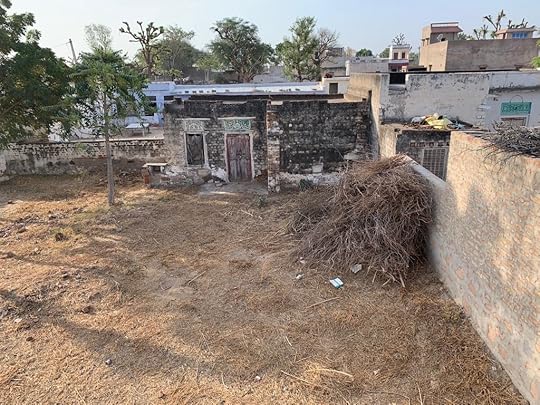 Image of my village from the same afternoon.
Image of my village from the same afternoon.That was one day where one needn’t be ashamed of tears. There is no embarrassment in crying out publicly. Some of them wept more from habit than from sorrow. In the village one is expected to demonstrate sadness in audible terms. The one who cries the loudest is the saddest, most people believe so. Though ones most affected by it are the silent ones. As they know for a grown-up man, sorrow is a secretive act.
On one particular evening I remember, my grandmother told my mother that when she dies she wants a band to accompany her funeral march. Inside the room, some debates arose among the important family members as to what her wish meant. Was she sarcastic, was she serious or was it just a statement which she said bereft of any specific meaning, while gazing at the sunset, in the colorful trance of exaggerated romantic after- death fantasies, The debate continued for a while to understand the real intent behind the statement.
Finally the family members lit the the funeral pyre. In the background, five people seriously debated about Modi and the upcoming election. One of them said “Tv Journalist Ravish Kumar said stop watching tv because there is too much propaganda” . Another one said that “ PM Modi will not cross 150 seats”. They laughed, clapped on the jokes and cheered each other on. In the background the smoke was rising far above on the trees, shooing away the peacocks. I thought of asking those people to stay silent but then I wasn’t aware of the decorum of village life. City folks are submissive to an ever-present gaze of self-conscious etiquette whereas the village life breeds on little reflexive joys.

Noon has passed. Everyone slowly started to make peace with the universal logic of ageing. Clouds of gloom began to settle down, at least for a while. Food was cooked and we ate together. My mother told me how disturbed she became after the death of her father that before sleeping every night she used to think about him voluntarily. Her rationale for this being that she had seen videos on youtube which said that when you think of someone excessively before going to bed then you will start seeing that person in your dreams. She desperately wanted to meet him once after his death. If not in real life then at least in her dreams.
A black cow kept on trying to enter the house. Someone shooed her away but she entered again. I thought about the film by Tsai Ming Liang where a mother is waiting for the spirit of her husband to enter the house after his death. One day her son tries to kill an insect. The mother screams and stops him by saying that it might be her father who is returning to earth in this new form. Even in Hinduism, there are chances that the dead might come in another animal form.
I remarked “ Grandmother is back. She is a cow in her new life”. And then everyone laughed, finally.
The laughter felt like a dilution of sadness for a brief moment before the arrival of warm sorrow in the upcoming night. Especially within the ones who slept on the roof while gazing at the infinite night sky with their eyes wide open.

September 23, 2020
Political Orgasm
Political Orgasm
Short Story by Anurag Minus Verma
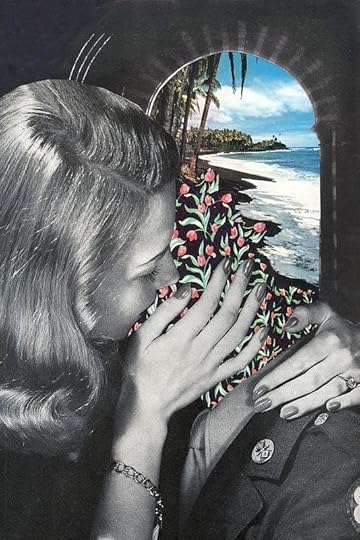 Art work by — Eugenia Loli
Art work by — Eugenia LoliShe is silently nodding now at a young man with grey, curly hair and an intellectually fatigued face; the kind generally found in men who have thrust intellectualism upon themselves via their righteous Facebook posts and now they feel they have to carry it everywhere, even during the most mundane conversations. Here, the topic is, “Is Modi a fascist?”
She walks off to the washroom, and finally takes a deep yawn. She pats her face softly with wet wipes, and wonders how long she will have to suffer these boring talks on her first ever Tinder date in Delhi, where she had come to attend a Comic Con. She notices a small blotch of Joker-inspired lip color near her mouth from the event, and out of sheer boredom, mimics “Why so serious…?”. Perhaps disgusted by her bad acting, she unlocks her phone and looks at his Tinder profile again. He looks more attractive on Tinder than in real life. Perhaps, she finds him hot when he doesn’t talk. She fantasizes grabbing his curly grey hair by the locks and letting him smell the Zara roll-on perfume she had specifically applied to her left breast. She wonders if this guy is as horny as her and if he’s using the Modi banter just to kill initial awkwardness or because he doesn’t find her attractive enough. She looks down at her belly fat and quickly pulls down her crop top, covering her tiny navel behind the Fabindia linen.
“Aren’t we living in an era of darkness, Ankita?” he asks, lounging on the Starbucks couch, sipping a cappuccino with a double espresso shot and almond milk.
“We are. But, what’s the solution?” she replies, putting on a sincere expression.
“We need to educate people. The problem of India is illiteracy. We need to post more political content on social media and educate everyone on why Modi needs to be thrown out of power to make India a better place.”
“That makes sense.”
“He uses the religion card every time. Like Marx said, “Religion is the sigh of the oppressed creature, the heart of a heartless world, just as it is the spirit of a spiritless situation…”
“It is the opium of the masses. I know what he said and I absolutely agree. No questions asked.” she replies quickly as to avoid listening to this cliche quote.
She picks up her chocolate croissant and takes a bite. The crisp ends fall all over her plate. To kill the awkwardness and the terror of sudden silence, she adds, “This man says he does yoga every morning but look at his physique. He is a liar! How can a yoga guy have such a round paunch?”
“Now, you are stepping into the fat-shaming club. I don’t agree with that. I think all body types should be respected.” he replies.
This gives her an equal dose of embarrassment and hope. With a sudden glee and confidence, she stealthily adjusts her crop top and her navel catches the golden Starbucks light again.
They step out for a smoke. The city is hustling in the dazzling madness of a Saturday night. He crushes the ice mint button of his Marlboro cigarette and passes it on to her. She thinks of complaining about the strong menthol flavor but gives up the idea.
“Do you drink?” she asks.
“Yeah, but I currently prefer only low carb beers because I am on a low carb diet.” he replies briskly, toying with the cigarette between his fingers.
She recalls a self-note from long back: Never trust a guy who orders low carb beers and quinoa salad on a date.
She looks at the stiffness of his body and wonders when he will shed this burden of profoundness and reveal his real ridiculous self. She notices an abstract tattoo on his left arm and is tempted to ask him about it, but then gives up the idea to save herself from another random philosophical attack.
“We can go back to my place for some drinks or would you prefer a bar?” he asks, genuinely.
“Anything is fine with me.”
“I think we should go back to mine because then we can roll a joint and listen to the music of our choice. These clubs play nasty Bollywood crap! I like minimal electronica. I am tripping on Nicolas Jaar and Acid Pauli these days. But don’t you think this weather is perfect for some Faiz Ahmad Faiz?”
“Oh! I can’t wait. Let’s go.”
Walking back to his place, his strong left arm occasionally brushes her soft right arm. It has been almost a year since she was physically intimate and now she feels aroused at the random place. Once she felt horny even while checking exam sheets with a teacher inside the school building where she teaches Social Studies.
At his neatly arranged apartment, a pile of books is placed on a table and a small bundle of The Hindu is lying in a corner. The blue walls covered with posters of Che Guevara and quotes by Noam Chomsky.
She recognizes a soapy smell of recently sprayed room freshener and wonders how he could be so sure of coming back here with his date.
The room is dimly-lit and his face glows in the screen light as he puts on a song on his laptop: ‘Hum dekhenge!’
He opens two pints of beer and both gulp down half of their bottles in one go. While rolling the joint, she thinks about various topics to come up with but abandons them so as to not be stabbed with the pocket knife of political correctness by this woke guy.
The song is suddenly paused by an online YouTube advertisement of Modi delivering a speech on dealing with exam stress. Out of sheer irritation, he gushes and skips the ad.
“What the hell! This man pops up everywhere.” he exclaims.
Seizing the opportunity to get the conversation going and eliminating the dullness, she promptly replies, “Yeah, I am so done with this man.”
“Seriously, ya! He drives me crazy! Always increases my stress levels. I’ve been suffering from anxiety lately.” he replies while violently gulping down his low carb beer.
She walks up to him and caresses his head.
“You need to take it easy and relax for a bit.” she says softly.
He performs some breathing techniques to calm down while she rubs his back. They remain in that position for a while. She can feel his breath, smelling faintly of chewing gum and tobacco. She gently presses her lips on his. He slowly scans her back with his fingers and then moves to the front. She can feel the rush already.
Her hands grip his grey curly hair. In the spur of the moment, she pushes his Ph.D. books off the study table and slips on to it. They kiss some more. She slides down her jeans, he takes off his pants, and feels her warm body. That drives him crazy. All the profoundness starts melting away, and finally, a natural, wild human side comes out in full display. She wanted to watch this face. This naked face without the stress of intellectualism. His vulnerable face without the make-up of wokeness. He takes her from behind. She takes control from the top. He licks. She sucks. The boring room of a Ph.D. scholar now dazzles with sheer madness of fresh love.
She wonders if common hatred, rather than shared love, brings individuals together. As the YouTube ad of smiling Modi pops-up again, she smiles back at him in gratitude for making this magical evening come true where she came three times in the last twenty minutes.
This is the short story from the book I love you but only on weekends by Anurag Minus Verma. Please buy the book on Amazon to read all the stories.

June 5, 2020
The real reason why desi celebs or even Savarana intellectuals will never say “Dalit lives…
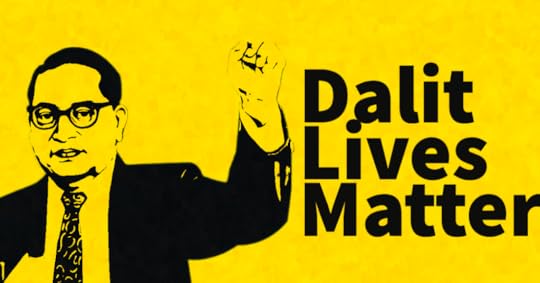
American cities are exploding. For long they have tried to subdue it, but now the frustration and anger has reached the tipping point and is oozing out on the street. The death of a black man, George Floyd, last week in Minneapolis set off days of waves of historic protest and exposed the dirty reality of The American Dream to the whole world.
The ramifications were so huge that even our desi celebs had to halt their cooking and work out Instagram videos for a while and make a post or two about this news. (Of Course, as advised by their PR )
In fact, it was so huge that one of my classmates from Jaipur, whose hobby was to pass random casteist statements at lunchtime, had posted on her Facebook — “Justice needs to be served. Like right now! #BlackLivesMatter.“
This brings us to the question — why your favorite celebs and upper caste friends are posting about a heinous murder that happened in a faraway land but they will never post about similar crimes happening in their own country.
There are lakhs of George Floyds in India (Read Dalits) who have died on account of the brutalities of our society. Why is it not ‘cool’ to speak out about Dalit lives and post DalitLivesMatter?
This is not limited to celebs or your upper castes friends. This also includes Savarna newsmakers and social media ‘influencer ‘who rarely give much space to Dalit issues. In fact, the only time Dalits catch any attention of liberal Savarnas is when there is an angle of Modi or BJP. Right-winger Savarnas would be interested in Dalit issues if there is some left/congress connection to it. But anyone who studies caste knows very well that the problem of caste has much more toxic and deeper roots that transcend any present-day government. Lack of reforms in upper castes and their lack of empathy for human dignity is one of the prime reasons for this disease.
Origins of ‘#BlackLivesMatters’
#BlackLivesMatter was started in 2013 by Alicia Garza, Patrisse Cullors and Opal Tometi to protest against the death of a 17-year-old African American high-school student in Sanford. The movement has now grown into a global network whose members “organise and build local power to intervene in violence inflicted on black communities by the state and vigilantes.”
#BlackLivesMatter movement is one of the most powerful examples of how social media conversations can be pivotal in bringing about social change.
This hashtag was amplified by black celebs/ opinion makers online and soon millions gave their support. This also includes prominent white celebrities.
The wide influence of this hashtag also needs to be understood from the lens of cultural capital which blacks have built over the years and their role in shaping up popular culture.
There are many black celebrities who have great cultural influence and are a source of inspiration and emulation for many. Black celebrities are among the most well-known who have the power to influence and set new trends among the masses. In music, Beyoncé is one of the top three trendsetting artists in the pop genre. Will Smith is a widely recognized actor working in Hollywood. Oprah Winfrey is one of the most influential television personalities. Michael Jordan, one of the most celebrated professional athletes of all time. The list is very long.
Their presence in pop culture is the reason that in contemporary times whenever any atrocity is committed by the state they have the power to spread their message across the world. This is also the reason that even white celebs/influencers can’t afford to not speak up about atrocities against blacks. Finally, this is also the reason why your upper caste friends find it so important that they will proudly tweet: Holy shit! #BlackLivesMatter.
Cultural capital of Dalits:
The situation in India is entirely different. So far, Dalits have not been able to tap into pop culture. There are very few in the opinion-making spaces and entertainment industry who can be powerful enough to shape the opinions of the majority. Even the privileged Dalits who are working in these spaces don’t have the courage to come out and reveal their identity. Their fear is also understandable. This terror of revealing identity has its roots in the shame and humiliation which is assigned by the upper caste society. Many Dalits treat caste as some kind of sadness that they are born with and now we somehow have to endure it.
In Bollywood apart from the filmmaker Neeraj Ghaywan, I have never seen any Dalit at the top position who came out to reveal his/her identity and paved the way for others to do the same.
The time has arrived to change the rules of the game. Social media has united Dalits and given them a platform to build strength. The time has arrived to shed this nonsensical shame of being Dalit and instead take pride in the very idea of being a Dalit.
Dalits have to tap into the popular imagination. Through the use of cinema, songs, writings, artworks, and even internet memes. Making any use of any popular mediums which help spread their message across and build their cultural capital. Dalits need to create their own celebrities and opinion-makers and not be at the mercy of Savarna influencers to speak about their issues. This group identification is essential for generating the solidarity and commitment necessary for taking collective actions which leads to social changes.
Definitely not an easy task to break this structure but in the contemporary world, it’s entirely possible.
Seize the pop culture, my fellow Dalits!

May 27, 2020
The strange and gorgeous walls of Shekhawati Havelis.
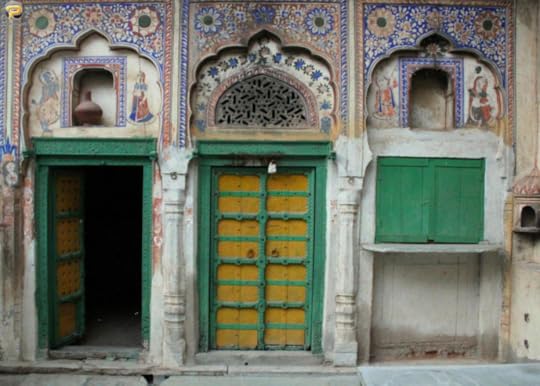
Till now you might have seen Shekhawati Havelis without even noticing that you have seen Shekhawati Haveli. Perhaps in movies or most probably on Instagram where some beautiful models are posing on the background of grungy walls of these old buildings.
 Credits: Dhruv Bandwal
Credits: Dhruv BandwalWhen you hear the word ‘Havelis’ it evokes certain memories in mind. Perhaps about Karan Arjun or Amrish Puri. But Shekhawati haveli is nowhere close to that. These monuments are a unique form of artwork that emerged at this quint region of Rajasthan known as the Shekhawati area.

Let’s first understand what is the Shekhawati region.
Shekhawati region is situated in the northeast part of Rajasthan. Three districts fall under the belt of Shekhawati — Churu, Sikar, Jhunjhunu. This area is famous for the old beautiful buildings which are known as Havelis.
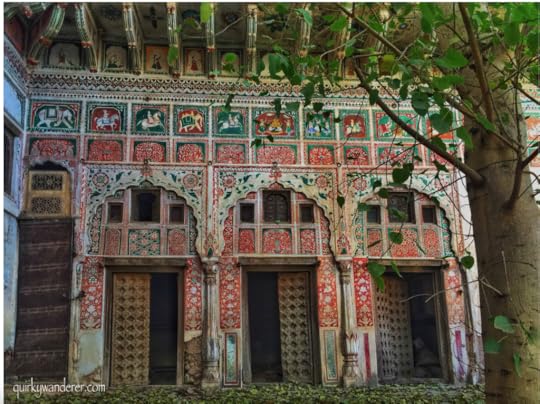
One of the major sites of Havelis in the Shekhawati region is -Mandawa, Fatehpur, Nawalgarh, Mukandgarah, Ramgarh, Churu. What makes these buildings unique and interesting is the design of wall paintings and its architectural style. Contents of these paintings are as diverse as it can get. Under the same building, one can find depictions of themes like mythology, aristocracy, local folk tale, smoking Jesus, even wicked erotica ( Queen Victoria is depicted performing intercourse with King Alexander).
 A quick history
A quick historyHavelis came into existence in the late 18th century. Shekhawati region of Rajasthan has a very strong number of Baniya community/ Merchant community which is collectively known as Marwaris. (Plot twist: Not all Rajasthanis are Marwari).
With the opening of the Delhi-Calcutta railway route in 1860, thousands of Marwaris from this region spread all over to states like Assam, Bengal, Orissa. Especially Calcutta became the headquarter of Marwari capital amassed through cotton, jute, oilseeds, opium trade. Among many other reasons, one reason for the huge migration of the Marwari population was the unfair taxes levied by the rulers of Bikaner and Jaipur. No matter what the reason was but migration proved to be boon for the community in terms of wealth.
The community prospered and how. Their level of prosperity can be gauged by the fact that out of 101 top business houses present, 27 are from the Shekhawati Marwari community.
Since the community members wanted something to give back to their birthplace they decided to put some share of wealth to the region where they were born. This is how Haveli came into existence.
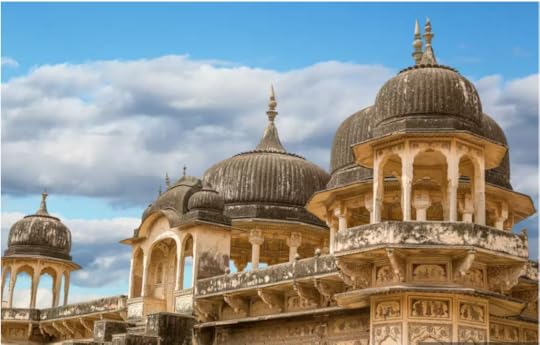
A number of Havelis were created which became the symbol of Marwari identity in the Shekhawati region. In Fact, these creations can be a product of envy and competition with other communities. Precisely Rajput community.
One of the largest communities of Rajasthan is Rajput. Rajput rulers were always involved in expanding their cultural heritage in the form of Paintings, monuments, buildings. Before the 18th century, the association of Art with the Marwari community was never heard of. Havelis became the first artistic symbol of their community.
Havelis were to Marwaris what forts were to Rajputs. Most of the painters who painted the walls of these Havelis came from the Rajput barons and this is the reason for the similarity in the style.
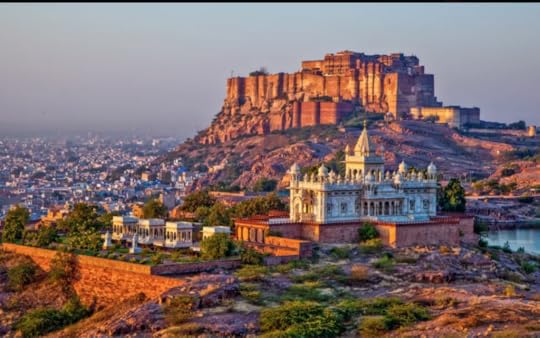

The walls of these Havelis are filled with beautiful wall paintings where various themes are being explored. Most of them were being made by using the Frescos technique. This is a very unique technique of painting.
Fresco is the style in which the artist paints the walls in the moist form i.e. at the time when fresh plaster is applied on the wall. Colors will get absorbed in the surface of the wall and the painting becomes an integral part of the wall. This is the reason behind the durability of these paintings which are there even after so many years.
It is evident by the fact that some of the wall paintings of these Havelis have been destroyed because of weather conditions and bad maintenance but the walls where fresco techniques were used are still alive and visible.
These walls serve as the canvas for a variety of paintings. Let’s have a look at what is being painted on the wall.
Radha Krishana

Almost every Haveli has the largest number of paintings about Radha and Krishana. They are projected doing playful activities like swinging, cuddling each other, or combing hairs. Rass Leela has been the popular theme in these paintings where Krishana is seen having good time with Gopis. There are also paintings of Krishana holding Mount Vrindavan on his finger , birth of Krishna, Krishna killing Pootna by sucking her breasts , Krishna dancing on Kaliya.

Epics like Ramayana and Mahabharata: The important events of these two epics are drawn on the wall. Especially the paintings associated with Ramayana hold the largest portions of many Havelis.
Mythological Gods: The Hindu trinity ‘ Brahma Vishnu Mahesh ‘is depicted on the walls of Havelis. Vishnu is mostly depicted resting on sheesha under the group of snakes, his wife Laxmi is seen pressing his feet. Through Vishnu’s navel, a lotus flower is seen coming out, on which Vishnu is seen resting. Shiv is presented in different forms which include Nilkantha Avataar and Ardhanarishvara Avatara.
At Poddar Haveli in Nawalgarh, I met an artist who created an Ardhanarishvara avatar of Vishnu and Laxmi. He claims that such Ardhnarishwar has never been painted anywhere.

There are some more examples of unusual depictions where Artist has taken the liberty of creative imagination. In the picture below painted at Jivrajka Haveli, Nawalgarh, Artist has painted Hanuman driving the carriage, and passengers are Krishana, his wife Rukmani, and Rama’s brother Lakshmana. This is of course cross fusion of Ramayana and Mahabharata. Pure fantasy on an artist.
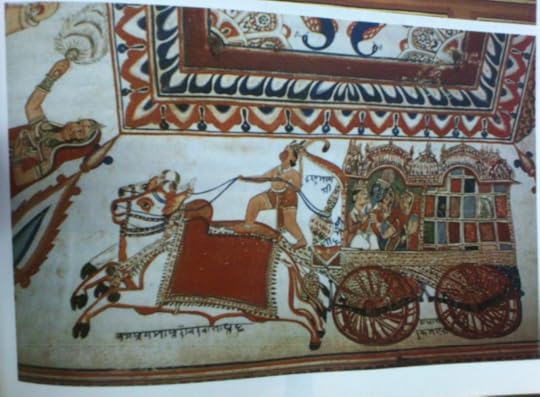
In the court of Poddar Haveli, there is an interesting Painting where Shiv -Paravati are riding on Nandi ( bull) and another mythological couple is seen riding on elephants. In the modern-day context, this can be seen as Marvel’s Avengers of Hindu gods.
Below is the picture was taken from Surajmal Banthia Haveli at Churu. This takes freedom of imagination to a different level where Jesus is seen smoking a cigar.
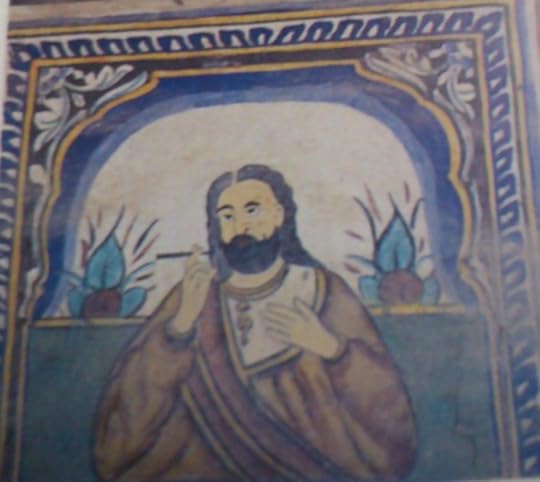
Depiction of British: The colonial period often termed the ‘golden age’ for the Marwaris, gave a tremendous boost to the fortunes of Marwaris. The British rulers actively involved Banias to expand their business. It gave these merchants stability which was missing in the earlier princely rule. British officers used to visit the Havelis in the Shekhawati region, thus painting them on the walls may have been an exercise to impress them, or perhaps it was a gesture of hospitality.
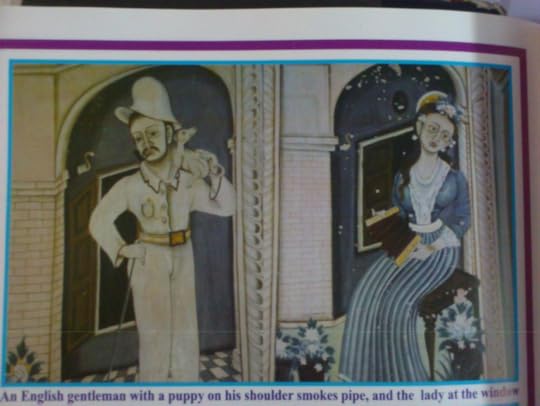
Local love stories of Rajasthan- Havelis walls possess a staggering diversity. Local Rajasthani folk tales were also given space at the Haveli wall. One of the most famous love stories of Rajasthan is the story of Dhola Maru. Another popular love story of Rajasthan is the story about Prithvi Raj Chauhan and Sanyogita. There is an interesting love story about Binjo and Sarnath. It is said that Binjo plays Veena so well that his young aunt named Sarnath fell in love with him. They are depicted in various wall paintings where Binjo is playing veena and Sarnath is seen dancing on it.
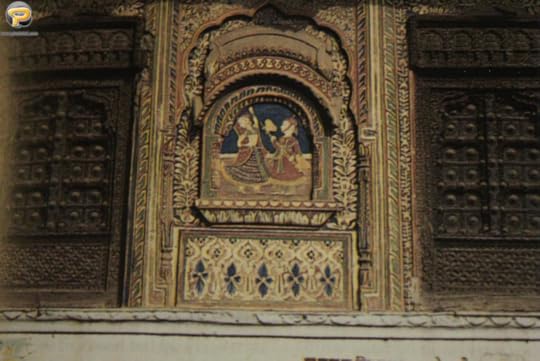 Binjo & Sarnath
Binjo & SarnathInfluence of Modern society — Till now in the name of vehicles only animals like Horse, elephant, were used ( or maybe cart). But later on, 20th-century influence can be seen in the paintings. Vehicles like cars and bicycles started to make their position on the wall. On the wall of Poddar Haveli in Nawalgarh, there is the painting of a train. It is said that it was painted during the time when the first train in India arrived. It was a spectacular event that created a buzz all over the country and the Shekhawati region was no different. It is said that to capture that spectacle of the first train, the artist went to Mumbai to see the train. He captured what he saw there on the wall of the Haveli and the result was this painting which is seen below.

Erotica: Erotica is another theme that features on the walls and bedroom. Though they were intentionally designed at interior places so it becomes difficult to spot them. There are some paintings of naked women and some are more explicit where couples are depicted in the middle of sexual activities.
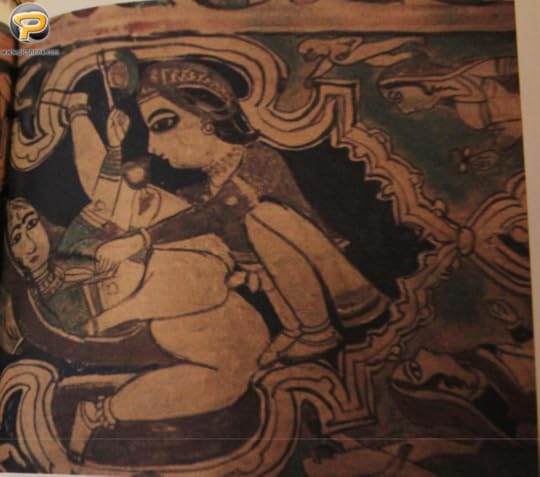
Some of the scenes where the couples were portrayed having sex were destroyed at the Ladia haveli in the Mandawa in 1984. What’s most wired is the depiction of themes of bestiality. A representation of males having sex with an animal.
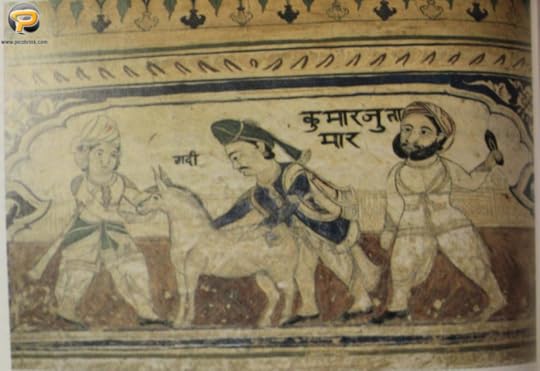 Kumar Juta Maar Painting
Kumar Juta Maar PaintingAbove is a painting at the Nawalgarh where a man is seen having sex with a donkey. A man behind him is about to hit him with the shoes. In a Shiv Narayan Haveli at Churi Ajeetgarh sex scenes of the Royal family are depicted in the bedroom. In one painting Queen Victoria is seen having sex with King Alexandra.
What is the reason behind these paintings is not quite known. Are these random paintings made by a wacky artist high on life or is there any deeper meaning behind the painting?
The current state of Haveli
Most businessmen have migrated from the Shekhawati Region. These Havelis are now abandoned and left in the hands of caretakers appointed by Marwaris. Some have been converted into tourist spots and many have transformed into Heritage hotels.
Apart from the popular ones, most of them are in a sorry state because of the bad maintenance. There have been attempts of renovation but it is only limited to a few Havelis. Some years back a French artist named Nadine le Prince bought a Haveli in Fatehpur which is now known as Nadine le Prince Haveli. It is no wonder that right now it is the most well preserved Haveli of that region.
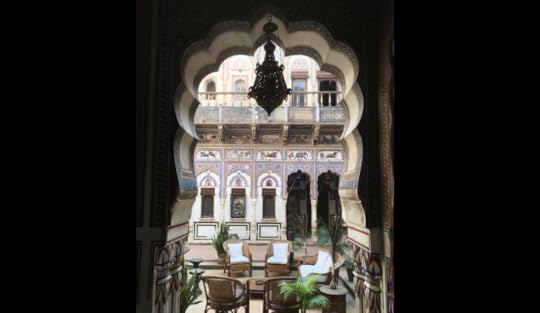 Le Prince Haveli
Le Prince HaveliFinal Words
Havelis are a unique fusion of rarefied art and kitsch design. Some of the paintings borrow from western aesthetics whereas some from Rajputana style. Nothing was considered too trivial to paint and that might be the reason behind such a wide variety of themes in these buildings. When seen in its entirety one can understand that it captures the rhythm and vibe of the Shekhawati region. Here nonsense exists with the sense. Sacred with profane. High art with low art. A unique amalgamation of carefreeness and the pure joy of creation.

April 25, 2020
Political Orgasm
Excerpt from the book I love you but only on weekends

She is silently nodding now at a young man with grey, curly hair and an intellectually fatigued face; the kind generally found in men who have thrust intellectualism upon themselves via their righteous Facebook posts and now they feel they have to carry it everywhere, even during the most mundane conversations. Here, the topic is, “Is Modi a fascist?”
She walks off to the washroom and finally takes a deep yawn. She pats her face softly with wet wipes, and wonders how long she will have to suffer these boring talks on her first-ever Tinder date in Delhi, where she had come to attend a Comic-Con. She notices a small blotch of Joker-inspired lip color near her mouth from the event, and out of sheer boredom, mimics “Why so serious…?”. Perhaps disgusted by her bad acting, she unlocks her phone and looks at his Tinder profile again. He looks more attractive on Tinder than in real life. Perhaps, she finds him hot when he doesn’t talk. She wonders if this guy is as horny as her and if he’s using the Modi banter just to kill initial awkwardness or because he doesn’t find her attractive enough. She looks down at her belly fat and quickly pulls down her crop top, covering her tiny navel behind the Fabindia linen.
“Aren’t we living in an era of darkness, Ankita?” he asks, lounging on the Starbucks couch, sipping a cappuccino with a double espresso shot and almond milk.
“We are. But, what’s the solution?” she replies, putting on a sincere expression.
“We need to educate people. The problem with India is illiteracy. We need to post more political content on social media and educate everyone on why Modi needs to be thrown out of power to make India a better place.”
“That makes sense.”
“He uses the religion card every time. Like Marx said, “Religion is the sigh of the oppressed creature, the heart of a heartless world, just as it is the spirit of a spiritless situation…”
“It is the opium of the masses. I know what he said and I absolutely agree. No questions asked.” she replies quickly as to avoid listening to this cliche quote.
She picks up her chocolate croissant and takes a bite. The crisp ends fall all over her plate. To kill the awkwardness and the terror of sudden silence, she adds, “This man says he does yoga every morning but look at his physique. He is a liar! How can a yoga guy have such a round paunch?”
“Now, you are stepping into the fat-shaming club. I don’t agree with that. I think all body types should be respected.” he replies.
This gives her an equal dose of embarrassment and hope. With a sudden glee and confidence, she stealthily adjusts her crop top and her navel catches the golden Starbucks light again.
They step out for a smoke. The city is hustling in the dazzling madness of a Saturday night. He crushes the ice mint button of his Marlboro cigarette and passes it on to her. She thinks of complaining about the strong menthol flavor but gives up the idea.
“Do you drink?” she asks.
“Yeah, but I currently prefer only low carb beers because I am on a low carb diet,” he replies briskly, toying with the cigarette between his fingers.
She recalls a self-note from long back: Never trust a guy who orders low carb beers and quinoa salad on a date.
She looks at the stiffness of his body and wonders when he will shed this burden of profoundness and reveal his real ridiculous self. She notices an abstract tattoo on his left arm and is tempted to ask him about it, but then gives up the idea to save herself from another random philosophical attack.
“We can go back to my place for some drinks or would you prefer a bar?” he asks, genuinely.
“Anything is fine with me.”
“I think we should go back to mine because then we can roll a joint and listen to the music of our choice. These clubs play nasty Bollywood crap! I like minimal electronica. I am tripping on Nicolas Jaar and Acid Pauli these days. But don’t you think this weather is perfect for some Faiz Ahmad Faiz?”
“Oh! I can’t wait. Let’s go.”
This is an excerpt from a collection of short stories named- I love you but only on Weekends. It is available on Amazon. Please check out by typing the name of the book.

April 13, 2020
Time to destroy the stereotypes about Dalit occupations
Ignorance of Indians about the top-notch expertise of Dalits
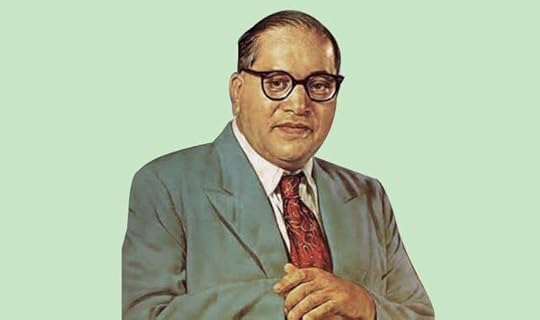
Recently many of us have seen/read news about few Indians thanking sanitation workers (read Dalits) by flowers for combating the corona pandemic on streets. Such rare gestures look pleasant but this doesn’t change the fact that these are mere gestures. It is no surprise that in these emergency times, many Dalits are out there and fighting the battle. The same community that is the most inhumanely treated in India.
I even heard a comment a few days ago at my apartment building that “We must thank these ‘lower castes’ who are taking care of sanitation issues in these tough times.“
Such comments are welcomed but I wondered if we have a misconception that the contribution of Dalits in India is limited to cleaning the dirt of society. Are we ignorant of the variety of occupations that Dalits are/were masters of?
Even at many urban intellectual gatherings, I hear condescending comments on Dalits. At a recent house party where we screened an art film, a well-meaning acquaintance of mine said in a calm meditative tone — “Someone told me last night that you are from a Dalit community.“ He made such a sympathy face as if I am suffering from an incurable disorder and he is with me in this situation of enormous grief. I recollected Nietzsche’s quote, “There is a rollicking kindness that looks like malice.”
This again brings me to previous question- What is a good way to express gratitude to Dalits? I feel acknowledging the suffering of the community is the first step. The next and important one is to understand and acknowledge that Dalits are the great masters of many crafts and their tremendous knowledge system has thus resulted in enriching the Indian civilization.
Dalits are artisan community
A Premiere institute of design in India — National Institute of Design ( NID) is a hub for creating some of the brilliant artists every year. Many get placed in some of the coolest offices/ventures all over the globe and are paid quite well for their worth. Interestingly, many of the design courses they teach on the campus traditionally belonged to the lower castes. Such as Textile design, apparel design, accessory design, toy design.
It is a very less known fact that Dalit occupations are in fact related to aesthetical designs. The traditional occupation of the Meghwal community in Rajsthan was weaving of fabrics like Khadi, a task many of the Meghwals are still practicing. The colorful embroidery made by Meghwal women has refined craftsmanship with rich colors, and precise motifs and is popularly known as Meghwal embroidery in the Indian textile industry.
 Meghwal Embroidery
Meghwal EmbroideryMany unknown Dalit artisans are indirectly the suppliers of the latest fashion trends emulated by the general public of our urban society. All modern hip brands benefit from Dalits craftsmen which include names such as- Esprit, Tommy Hilfiger, Zara, Mango, PUMA, Prada, and Marks & Spencer. The craft of many low- caste cobblers is the force behind creating suave sling bags of the elites and middle class of the cities; an important flaunt-worthy item in their accessory.

In Bengal, the earliest successful craftspeople of the Indian musical instruments were mostly from the bottom layers of caste hierarchy. Namasudra and Poundra communities of Bengal, two scheduled caste communities, are known for possessing extraordinary skills of manufacturing classical musical instruments.
Gond paintings originating from the state of Madhya Pradesh are made by a Schedule Tribe. It has its roots in ancient tribal beliefs and traditions and these are very sought after paintings in the global art market. Paintings by artists such as Mayank Shyam ( Son of Jangarh Singh ) are sold in lakhs. There are demands for the artwork internationally and these paintings can be found in posh art galleries, five stars, or in the spotless modern houses of billionaires.
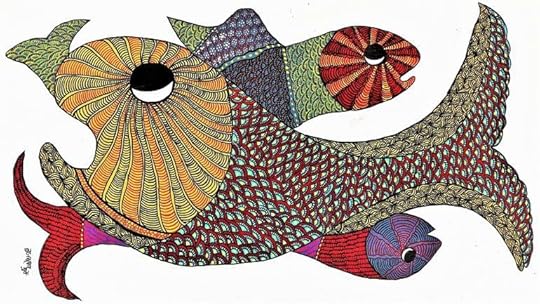 Gond Painting
Gond PaintingIn U.P, the Dalit community of bunkers is responsible for producing the top class handloom production in India. Especially in Benares, this dying art is associated with the creation of famous Banarasi Saree. One might see it in movies, donned by your favorite actresses or in a wedding where it enhances the charm of both married and yet to be married.
When we talk about footwear, we all know about Kolhapuri sandals, manufactured in Maharashtra. Another stylish footwear in India is popularly known as Punjabi jutti (Shoe) which has unique designs and intricate patterns. These Jutties are manufactured in a Punjabi town named Muktsar. Despite having possessed such an intricate art their work is looked down upon in the social hierarchy. The same jutii which taps on the songs of Badshah and Hardy Sandhu in night clubs have a history of caste discrimination for its creator.
 Punjabi Jutti
Punjabi JuttiAs put by writer Siriyavan Anand, “The commodity is aestheticized but the person responsible for it, and indeed the community, suffers humiliation. At the abstract level, the Dalit product is appreciated, but the Dalit person — the concrete being is humiliated.”
Pride in being Dalit
A sense of inferiority complex is part of the experience of being a Dalit in India which is a direct result of conditioning set up by upper castes. Dalits themselves are unaware of their worth due to lack of information and the fact that we don’t have a culture of documenting achievements of Dalits. This has resulted in perpetuating this sense of underconfidence which, in a subtle psychological way, is causing enormous suffering to many Dalits.
Dalits have a lot to be proud of their identity, their culture, their unique skills, their knowledge system and finally, their contribution to nation-building.
We must introspect why the brilliant minds of the subcontinent were humiliated and subjugated to the worst treatment. Shouldn’t we introspect more on this? Isn’t this a collective failure of the nation?
Time has arrived to celebrate and acknowledge the contribution of Dalits communities in the field of artistic, intellectual and technological fields so that Dalits no longer feel the need to hide their identity. So that Dalits can just laugh out loud on dumb casteists comment on-campus that ‘Quota people are talentless.’
Hope in the glorious future a Dalit identity becomes a matter of absolute joy.

A city robbed of its music
A poem on corona lockdown
by Anurag Minus Verma

Parks empty,
deserted even by the best of lovers,
cars on the parking lot
standing,
finally at ease,
like homeless men lounging on the beach.
Nothing moves on the road,
Streets and buildings like still photographs
Birds gliding over the city,
So many of them
giant screams of malnourished crows,
few sparrows chirping out of boredom,
and then this ghost city,
Takes the shape of a gloomy video on pause.
nowhere to go in the morning,
no aimless strolling in the city.
a city robbed of its rhythm
a city robbed of its music.
Jobless men locked in their home
alone or with their wives,
some smoking cigarettes on the balcony,
Listening to the radio, retro 70’s songs
about broken days
broken nights
and how nostalgia
slips by
riding on the breeze
one fine evening,
as the sound of email notification buzzes,
“ This is a tough time and we can’t provide any salary from next month. But we all are together in this and we will come out stronger “
Evening turns into night
news flashes new deaths, new infection
number of people who have died,
and the number of people who will die,
Numbers
and more numbers
and the whole
world like a giant
hospital.
A lady in the nearby apartment stays alone with two dogs
her kitchen sink,
clogged with
leftover food,
utensils,
a small pond built on the sink
she looks at her reflection in the water,
a face like rose dried inside the pages of pulp literature,
And she tries to flush it down
with the forks,
with an old toothbrush,
but it won’t drain, stays there like an uninvited misery,
all of a sudden it all goes down.
in one go
“ whoosh”
like an uninvited misery.
Late in the night dogs on streets
have joined together
barking, screaming, crying
because of hunger,
cats too cry late at 1 am,
like young children
who have seen ghosts,
ghosts smiling with shining pink knives.
We are all in it,
all marked on the hit list,
the hurricane may any time approach at the doorstep
like a hired assassin.
or perhaps soon
new beautiful sunshine will appear,
which no one has seen before
and out of nowhere,
all the piled up melancholy
will go down the sink.
“Whoosh!”

April 6, 2020
Philosophy and genre politics behind the acid western film of Jim Jarmusch
by Anurag Minus Verma
“Nothing is original. There are a limited number of stories to tell. But there is an unlimited number of ways to tell those same stories. I am more interested in forms.“
-Jim Jarmusch
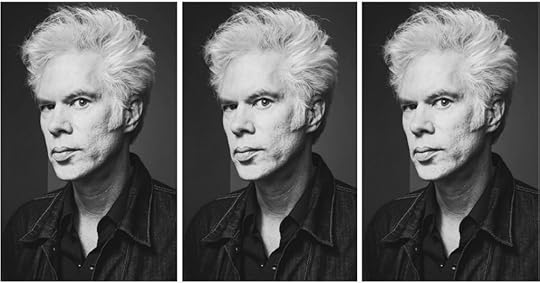
Jim Jarmusch’s name is not something which one can be associated with the genre films. Most of his films, made outside the support of the conventional studio system, have a distinct minimalistic indie flavor to it.
His characters are drifters, aimless young people who are constantly on the run. Sometimes characters are just drifting on the streets of the deserted city ( Stranger Than Paradise, Permanent Vacation ), sometimes swimming and running (Down by law), sometimes inside the cab ( Night on Earth ), and in the case of Deadman, they are on a spiritual journey on horses and boat.
Jim Jarmusch is interested in presenting the idea of America through the eyes of strangers or outsiders. He is interested in multiculturalism and the point of view of people who don’t belong to mainstream America. This is in fact the most consistent theme in all the Jarmusch films. In Stranger than Paradise, the lead character (John Lurie) speaks in the Hungarian language. There is an Italian main character in Down by law. Japanese characters in Mystery train. Night on earth consists of people from different nationalities. Here in Deadman, the character of Johnny Depp is an outsider in the city and his accomplice named ‘nobody’ belongs to the native Indian Race.
Dead Man is the film that comes at an important period in Jim Jarmusch’s filmmaking career. After the release of Night on Earth( 1991), Jarmusch took a hiatus of almost five years to make his new film Dead Man.
His earlier films were more about the style and cool nihilism where characters are flowing through strange relaxing boredom of their mundane lives. It won’t be wrong to say that Dead Man is one of the most self-aware films of Jim Jarmusch where he is trying to touch upon the loaded themes of spirituality, life after death, politics, genre revision et al.
 Western Genre and Deadman
Western Genre and DeadmanAndré Bazin once said, “ The western is the only genre whose origins are almost identical with those of the cinema itself “.
The first narrative film ‘The Great train Robbery’ was the western film. Below is the iconic image of a cowboy pointing a gun towards the audience which has similarities with the poster of the film Dead Man.
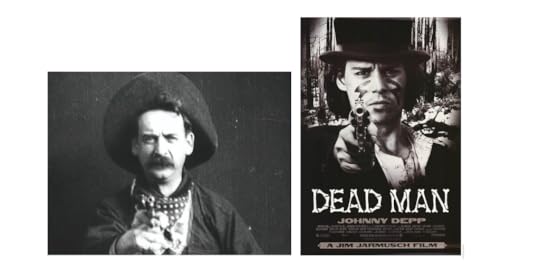
Behind every genre, there is a literary source and for westerns, it was cheap dime novels. Dime novel, a type of inexpensive, usually paperback, melodramatic novel of adventure popular in the United States roughly between 1860 and 1915. Directors like John Ford helped in establishing the cinematic syntax of the western genre. But these simple tales of good vs. evil were soon replaced by the uber-cool Spaghetti Westerns- an Italian version of Western.

Spaghetti Westerns mark a very important period in the history of cinema. It emerged after the decline of socially relevant and critically acclaimed movement- Neo-Realism. The vanishing of Neorealism can be attributed to the changing scenario in Postwar Italy. As Landy described in her essay “ It was not that neorealism had vanished due to overexposure or the loss of creativity but, more to the fact that social and political concern had changed “.
It brings us to an important observation that the mood of the nation in a particular period in history is crucial in defining the genre system. The emergence of Noir films in the Post War depression era or Road movies in counter-culture of the ’60s does affirm to the fact that these films represent the value system of a nation at a specific era.
Genres films exist within a certain scope whose vocabulary and elements are already defined. For instance, a comedy or a horror film will have a particular set of attributes that are already known to the audience. Then the question arises why the audience invests their time in the repeated nature of the genre system where they are already aware of what is going to happen in the movie.
In the essay questions of genre, Steve Neale has pointed to Williams definition of Genre: “The repetitive nature of genre production and consumption produces active but indirect audience participation; successful genres are ‘stories the audience has isolated through its collective response ’ Hence genre filmmaking can be examined as ‘a form of collective cultural expression.”
Revisionist films are those which break the myth-making approach of the genre film by bringing in new elements in an existing genre which differ from the typical treatment of the genre.
Deadman belongs to the same category of Revisionist western film that tries to break some of the myth-making notions of a western film.
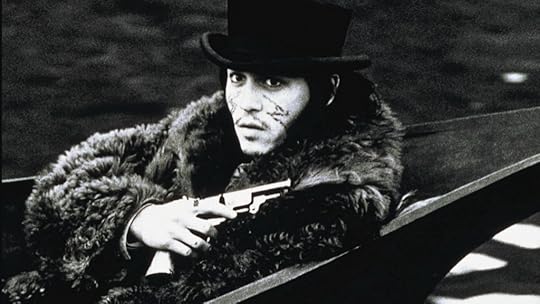 Poet William Blake and Deadman
Poet William Blake and DeadmanDeadman is a story about a man’s journey to spiritual realms. To tell this story Jim Jarmusch has chosen the form of Western Genre which is a bit strange because the element of spirituality might be the last thing to expect from a western film. Also, what’s more interesting here is William Blake’s connection with this western film. As discussed earlier in this essay, the literary sources behind the western film are cheap dime novels but the source behind the Deadman are poets like Henri Michaux and William Blake. These sources also explain the treatment of the film.
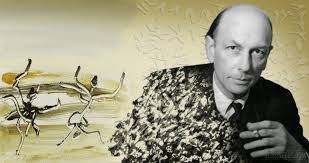 Henri Michaux
Henri MichauxThis is the film where William Blake (Johnny Depp) comes to the town in search of the Job which eventually he didn’t get. By the turn to events, he goes on a spiritual journey with the help of an Indian named ‘Nobody’ (Gary Farmer). The film can be defined as a character’s journey from age of innocence to the age of experience. William Blake has printed two famous volumes of poems titled- Age of innocence and Age of experience. There is a scene where Johnny Depp is with a girl named ‘thel’ (Milli Avital). This is again a reference to William Blake’s book ‘The book of thel ‘, and specifically to the visual representation of the poem ‘the sick rose’. In one scene Thel gifts William Blake( Johnny Depp) a paper rose. Later in the scene, her ex-lover arrives in the room where she is making love with William Blake ( Johnny Depp) and the situation turns ugly. Gunshots are fired from both ends. This scene is Visual representation of this poem by William Blake.
O Rose thou art sick.
The invisible worm,
That flies in the night
In the howling storm:
Has found out thy bed
Of crimson joy:
And his dark secret love
Does thy life destroy?
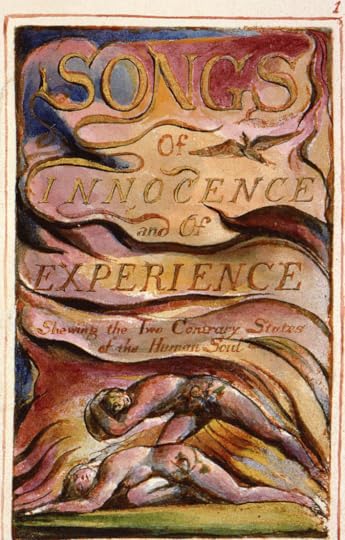 Road Movies and Westerns
Road Movies and Westerns
Deadman is termed as revisionist western but there are also elements of Road movie genres. The moment Johnny Depp’s character meets native American and they embark on a new journey the film acts like a Road movie; a genre that is about characters leaving behind their mundane world in search of self-realization.
Deadman in that sense can also be read as a multi-genre film. A film where the syntax of one genre is mixed with the semantics of another.
As Rick Altman wrote “ In addition, a dual approach permits a far more accurate description of the numerous intergeneric connections typically suppressed by single-minded approaches. It is simply not possible to describe Hollywood cinema accurately without the ability to account for numerous films that innovate by combining the syntax of one genre with the semantics of another. “
This leads to a larger question about the generic similarity of Road movies and Western film. Some have argued that Road movies have picked up where Westerns have left. For instance, Easy Rider (1969) is said to be a Western film but with a different value system, where early modes of transportation have been replaced by new inventions like motorcycles. Western films and Road movies explore the landscape and location which help in building a national identity. Monument Valley plays an important location in Easy Rider, the beauty of which is enhanced by montage shots of two young men riding on their super cool bikes.
Monument valley was entered into the cinematic space in John Ford’s westerns. So this particular location has a strong connection to the western film and its images can transport a spectator’s memory back to western films. Easy rider is also not shying away from the fact they are carrying forward the legacy of the western film which is evident in the scene where Protagonists of the film repair their bikes. This shot is cut to the feet of a horse that belongs to cowboys standing nearby dressed in traditional costumes. Needless to say, this scene refers to the relationship between western and road movies.

It is quite clear that it is not merely the genre that Jarmusch is interested in but he is more interested in the scope of a cinematic genre.
In the initial scene of the film many people in the train hunt buffalo with their gun. A man says “ they have killed many of them.“ Slaughtering buffalo is the sign of American imperialism upon the marginalized Indians by killing their source of livelihood.
Some U.S. government officials even promoted the destruction of the bison herds as a way to defeat their Native American enemies, who were resisting the takeover of their lands by white settlers. One Congressman, James Throckmorton of Texas, believed that “it would be a great step forward in the civilization of the Indians and the preservation of peace on the border if there was not a buffalo in existence.” Soon, military commanders were ordering their troops to kill buffalo — not for food, but to deny Native Americans their own source of food.”
In Deadman, Jim Jarmusch is using this old genre to present a point of view about America.
As he said in one of his interviews “The western as a genre doesn’t interest me,” he further adds “I don’t like John Ford, for instance, because he idealizes his characters and uses westerns to enforce some kind of moral code. It seems as if he’s telling nice American stories, but his films actually reinforce all the worst things about America, and I don’t like that subterfuge“
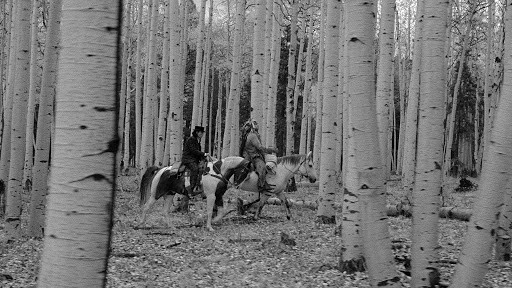
*All images are taken from the internet. I don’t have any copyright over it.

July 13, 2019
A messy love affair
A messy love affair

In a viral video Sakshi, a daughter of Bareilly MLA, announces to the nation (especially to her father) her love for Ajitesh. She fiercely tells her father, who is harassing the couple, to back off or face the consequences. Sakshi Misra has alleged that her father and others were out to eliminate her and Ajitesh.
She is now giving teary-eyed interviews to the news channels and visibly going through serious emotional trauma. Sakshi has not only committed the crime of falling in love with a man but a larger crime of falling in love with a Dalit man. She is not just posing a threat to Indian patriarchy but also to our nation’s favorite discrimination sport- casteism.
One just has to check the comments on Instagram and Facebook which are heavily against Sakshi. India is angry with Sakshi for choosing love instead of parents. In an average scenario, we would have believed Sakshi to submit to her fate to the idea of Indian unfulfilled love. After all, in India love is a secret part-time vocation to be performed in the trance of youth, away from the eyes of your parents and relatives.
Caste has proved to be the graveyard of love. The slayers of romance are either the family member or sometimes lovers themselves who are nothing but the clones born out of our very own regressive society. I have seen many passionate love affairs of my friends to be bulldozed by the JCB of casteism. Mad with the hurricane of love, many of them wished to get married but in the end, the family didn’t pay any heed to their desires. In some cases, girlfriends have started maintaining the distance when they came to know about the caste of these Dalit men who first seduced them with their charm but later turned them off by revealing their caste. During my college time, one of my close female friends had to deal with the trauma of a very rough heartbreak when her upper caste boyfriend broke the 5-year-old relationship by declaring that his family will never agree to the marriage. She still wonders why boys suddenly become meek when it comes to convincing their family, even when a large part of their youth is spent listening to the songs of rebellion and using the phrases about fucking the system.
In this context, the video where Sakshi is taking ownership of her love life has the signs of very important social undercurrents.
Inter-caste marriages are still very rare in India. Many states are giving incentive for a legal inter-caste marriage where a couple can receive around 2.50 lakh per marriage. However, according to the India Human Development Survey, only about 5% of Indian marriages are inter-caste.
One should also ask a larger question what kind of changes inter-caste marriages can make to dismantle caste? One answer is that dilutes the idea of purity and creates confusion. The idea of purity has clarity whereas confusion is very ambiguous. For instance, misleading surnames have long created confusion and in a strange way helped to dilute caste in public spaces. Random people in public spaces are curious to know your surname. Especially in trains, the decision of talking to you or sharing the food with you will depend on your surname.
These days it is becoming difficult to identify the exact identity of a Dalit by the surname. Many Dalits have surnames like Verma, Singh, Panwar, Choudhary. These are the same surnames which are also used by many upper castes. This confusion creates unrest in the caste curious upper caste person who is out there to judge you on the basis of your surname but getting frustrated by the lack of clarity in the surname.
The caste system is hereditary, and the whole idea of marrying within the same castes ensure the preservation of the purity of the caste system. If Dalits are marrying upper castes then it creates a strange social-cultural Integration where the caste identity will be diluted for the upcoming future generation. This is one of the most dangerous threats to society and which is the reason why there is a fierce opposition for the inter-caste marriages.
Dr. Bhim Rao Ambedkar married Mai Savitha Ambedkar, a Chitpavan brahmin from Maharashtra. In 1936 Ambedkar wrote a speech Annihilation of caste where he said “ Inter-dining and inter-marriage are repugnant to the beliefs and dogmas which the Hindus regard as sacred. Caste is not a physical object like a wall of bricks or a line of barbed wire which prevents the Hindus from co-mingling and which has, therefore, to be pulled down. Caste is a notion, it is a state of the mind. The destruction of Caste does not, therefore, mean the destruction of a physical barrier. It means a notional change,”.Ambedkar, however, believed that real change will not come by criticizing or ridiculing those who don’t practice intercaste marriage or inter-dining but by dismantling the authority of Shastra from where the very idea of caste emerged. He further adds “ Make every man and woman free from the thraldom of the Shastras, cleanse their minds of the pernicious notions founded on the Shastras, and he or she will inter-dine and inter-marry, without your telling him or her to do so.”
The social project of achieving complete annihilation of caste has very different means and we have still not figured out the correct cure for it. Lovers loving freely irrespective of caste is a potent punch on the face of the established order. The real brand ambassadors of ‘New Idea’ are such youths who are rebelling against the old dogmas and risking their lives by believing in the idea of love. If we fail these lovers then we will fail as a nation.




